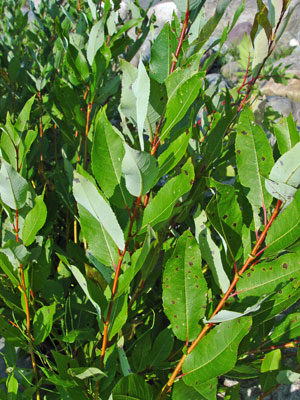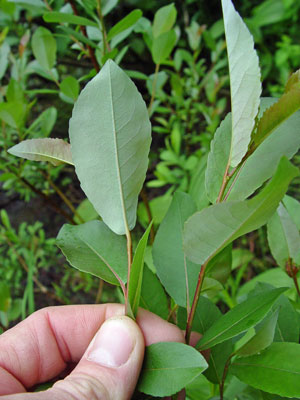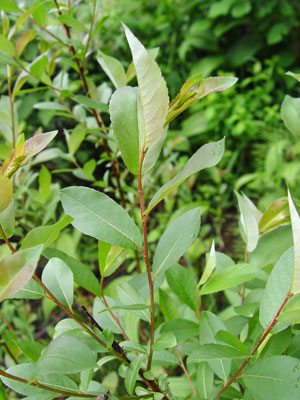DACF Home → Bureaus & Programs → Maine Natural Areas Program → Communities, Plants, and Animals → Rare Plants → Salix myricoides

Salix myricoides Muhl.
Blue-leaf Willow
- State Rank: S2
- Global Rank: G4
- State Status: Threatened
Habitat: Banks of streams, pond-shores and low thickets. [Non-tidal rivershore (non-forested, seasonally wet)]
Range: Newfoundland and eastern Quebec to northern Maine and the Great Lakes region, south to Illinois and Wisconsin and north to Hudson Bay.
Aids to Identification: Willows are recognized by their winter buds and flowers. Their buds are covered by a single, cap-like scale. Their flowers are very small and are borne in catkins. Identification of willows is complicated by the fact that these plants are dioecious - the staminate and carpellate flowers are borne on separate plants. This willow is best identified in late spring by examining carpellate (ovule-bearing) flowers. It, like the common Salix eriocephala, has dark-tipped floral bracts and glabrous ovaries. Salix myricoides has long styles (0.5-1.5 mm long), and its aments are borne on branchlets 0.5-1.5 cm long. Mature vegetative specimens resemble several common species. The combination of relatively thick leaves with stipules rounded to subcordate at the base and somewhat sharply toothed as well as conspicuously glaucous undersurface (whitened by a bloom) serves to identify this shrub.

Ecological characteristics: In Maine, this species has been documented to occur along the St. John River.
Phenology: Flowers April - June
Family: Salicaceae
Synonyms: Maine and New England populations represented by var. myricoides. Synonyms include Salix cordata Michx. var. glaucophylla Bebb; Salix cordata Michx. var myricoides (Muhl.) Carey; Salix glaucophylla (Bebb) Bebb; Salix glaucophylloides Fern.; Salix glaucophylloides Fern. var. glaucophylla (Bebb) Schneid.

Known Distribution in Maine: This rare plant has been documented from a total of 13 town(s) in the following county(ies): Aroostook, Somerset.
Reason(s) for rarity: Suitable habitat scarce.
Conservation considerations: Known populations are small and subject to the vagaries of small populations like random fluctuations or localized disturbance events. Populations could be harmed if all-terrain vehicle use of the habitat increases.
For more information, see the Native Plant Trust's Conservation Plan for Salix myricoides.